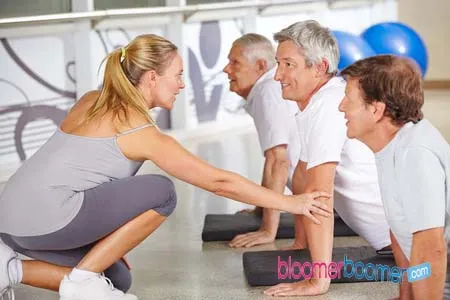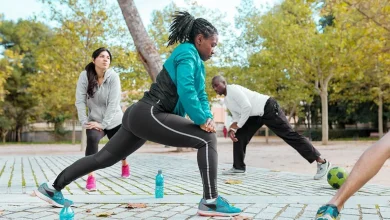Many Baby Boomers race to keep fit, put focus on staying in shape

By David Leon Moore, USA TODAY
CALABASAS, Calif. — Ron Paquette is always running. He even runs the 2 miles to work, from his home in West Los Angeles to the UCLA Medical Center, where he is a hematologist, treating leukemia patients. Sometimes he runs here, on the spectacular but brutally steep hills in Malibu Creek State Park, amid the gorgeous Santa Monica Mountains.
One running trail in the park is called Bulldog, and it goes up, up, up, testing lungs and Achilles tendons for 3.6 exhausting miles. When Paquette runs it, he is a bulldog running Bulldog. He is faster than almost everyone else his age up these hills and faster than many half his age. In his 50-59 age group, he won a 25-kilometer race on these trails in August by a whopping 22 minutes.
Paquette is 52, a Baby Boomer surrounded by Boomers who are running, cycling, swimming, boot camping — doing just about anything that will keep them fit, outdoors and among friends.
And, it seems, prove something to themselves.
Many people Paquette’s age jog around the block or even run 20 or 30 miles a week. Why train so hard to be fast? Why did Paquette run 50 marathons before his 50th birthday? Why does he still force the pace up Bulldog?
“It seems like a way to define my existence,” he says. “It doesn’t really matter what the times are. They’re not that extraordinary. It’s just something that defines me. And no one can take it away from me. It never goes away.”
In some ways, Paquette speaks for a generation that helped to usher in a new focus on physical fitness.
Sure, there are fat Boomers and lazy Boomers and Boomers who have no desire to run around the block, much less up a steep mountain. But there also are running Boomers and cycling Boomers and swimming Boomers, marathoners and triathletes and boot campers who are defining themselves not by what they do Monday through Friday but what they do on Saturday and Sunday.
Marathons and triathlons — an ever-growing event that combines swimming, cycling and running — have swelled in numbers of races and in participants during the last 10 years, and Boomers are in large part driving that growth.
The oldest of the nation’s 77 million Baby Boomers (those born from 1946 to 1964) are entering retirement — and many are pinning bibs to their chests and gathering at the starting line.
USA Triathlon had 58,073 members in 2005. This year, it had 134,932, and, despite their advancing age, Boomers make up almost one-fourth of that membership — more than 32,000.
Boomers also make up more than one-fourth of the membership of USA Cycling— about 17,000.
Distance running’s popularity among Boomers has helped to create unprecedented demand for starting spots in big-city marathons. The Holy Grail of marathon running is, of course, Boston, the only U.S. marathon in which a runner must post a qualifying time to gain entry.
In past years, eligible runners could sign up for the Boston Marathon, which is held every year in mid-April, practically up until race day. Then, in 2009, the race closed — at about 27,000 entries — in November. Last fall, spots in the 2011 Boston Marathon were gone eight hours after sign-ups began, on Oct. 18.
Of the roughly 27,000 runners in Boston this spring, about 7,500 will be Boomers.
New York Road Runners CEO and President Mary Wittenberg, 48, calls Boomers “trail blazers” of participant sports and general fitness.
NYRR stages a number of events but its biggest one — in fact, the biggest marathon in the world — is the ING New York City Marathon. On Nov. 7, about 45,000 runners started the 26.2-mile, five-borough trek. Almost a third of the field was from the Boomer generation.
Wittenberg is excited about bringing Boomers’ kids into NYRR events.
“Now we’re starting to see 20-year-olds and older running after college,” she says. “Their parents are Baby Boomers, and they grew up in a household where mom and dad ran.”
For ‘the adventure of it’
Ron Paquette isn’t the only Boomer hitting the trails in Malibu Creek State Park.
On any Saturday or Sunday morning, the park is crawling with Boomers.
They are doing 15-milers, 18-milers, running to an obsolete Nike missile base, where anti-aircraft missiles once were ready to shoot down invading aircraft, back when Boomers’ parents worried about such things. They run past the site where the opening sequence of the landmark TV show M*A*S*M*A*S*M*A*S*H, a Boomer favorite, was filmed.
Sometimes, when they are training hard or feeling particularly frisky, they run from the San Fernando Valley all the way over the Santa Monica Mountains to Pacific Coast Highway, and down PCH to Venice. It’s known as the Beach Run, a 23-miler that, on a sunny day, has to be one of the prettiest long runs anywhere.
“Part of this lifestyle to me is just the adventure of it,” Paquette says.
“Regardless of how the job is going or what’s going on with the family, in a short period of time I can be up in the mountains on a run.”
Bob Babbitt, the editor-in-chief of Competitor magazine, which chronicles the exploits of endurance athletes, has seen thousands of Ron Paquettes.
He’s a Boomer, too, 59, and a veteran of marathons and triathlons. He thinks he knows why he and a lot of male and female Boomers like him do this stuff.
“Our parents are from a different era — the Depression, World War II,” he says. “Their whole mandate was to provide for the family. In the 1950s, when a lot of us were born, our parents had different values than we do now. The work ethic was the main thing. Get a house, pay it off. Be a doctor. Be a lawyer. Sports were seen as frivolous.”
Then, Babbitt says, the world changed, and Boomers changed with it.
“We began to question some of those values,” he says. “We started to say, ‘You can have all the money in the world, but if you don’t have your health, what does it matter?’ We started looking for another challenge. We started to say, ‘What’s next?’ ”
And many Boomers, Babbitt says, started to look at running, cycling and swimming — activities that provided not only fitness but also camaraderie, travel and an appreciation of the outdoors and nature.
One of them was Russ Jones, 55, a recently retired mail carrier who lives in San Juan Capistrano, Calif., and is an avid triathlon competitor and coach. Jones looks around him and sees two distinct groups of Boomer men.
One group is found on couches, clicking the remote, transfixed by televised sports. Typically, their main exercise is to and from the refrigerator, and their competitive juices manifest themselves in fantasy leagues.
The other is found on trails, roads and open water, burning calories, challenging themselves and their friends to go harder or farther, and their competitive juices manifest themselves in 5Ks, 10Ks, marathons and triathlons.
Jones is clearly in the latter group, regularly competing in triathlons.
“This keeps me young,” he says. “I feel healthy. I feel exuberant. It’s fun.
“It’s my passion.”
Jones says his competitive age group — 55-59 — is getting larger and larger.
“Aging Baby Boomers are staying with the sport,” he says. “You’re going to see these age groups continue to expand. It’s part of our generation. They like the challenge. They want to be healthy. They all want that fountain of youth.”
How long does Jones expect to compete?
“I hope I cross the finish line when I’m 100,” he says, “and just die right there and win my 100 age group.”
Hugh Delehanty, senior vice president and editor-in-chief of AARP Publications and a former editor at Sports Illustrated and Women’s Sports and Fitness, says Boomers “reinvented participant sports, just like they did everything else.”
Delehanty says Boomers were raised with a high level of expectations placed on them by parents whose own expectations were altered by the Depression or World War II.
“To some extent, they’re living out the failed expectations of their parents,” he says. “A lot of them have fulfilled a lot more of their expectations than their parents did. Athletics is one of those areas.”
Those expectations, he says, also are a reason Boomers don’t just participate but compete.
“Boomers have incredibly high expectations of themselves,” Delehanty says. “They want to perform at a high level.”
Rising opportunities for women
For some female Boomers, sports opportunities were limited when they were in high school and college.
Not until Title IX became law in 1972 did women have widespread opportunities in sports. Some Boomers missed out on that. Some benefited a little.
Karen McKeachie, 57, of Ann Arbor, Mich., was a great runner when she was young, but her high school didn’t have girls track or cross country and she was not allowed on the boys team even though she recalls beating all but two of the boys entered in a cross country exhibition race.
She ran on Michigan State’s earliest women’s track and cross country teams in the mid-1970s and after college ran some fast marathons, including a 2-hour, 48-minute marathon in New Orleans that was good for third place among women.
WHAT GENERATION ARE YOU? Take the quiz
MORE BOOMERS: Stories, photos, videos, graphics
After suffering some overuse injuries from all of the marathon training, she heard about triathlons in the early 1980s. She entered one, did well and soon wound up in Hawaii, at the famed Ironman Triathlon.
She has completed nine Hawaii Ironmans, including an eighth-place finish in 1984. McKeachie says she was a tomboy when she was a girl.
“When I was 5, my dad bought me a Tigers baseball uniform,” she says, “and I distinctly remember an argument between him and my mom, who was saying that this wasn’t a proper thing for a girl to be wearing.”
She eventually won over her mom, though.
“One time I got a football helmet,” she says. “My mom let me sleep with it.”
Why has the need to compete in sports lasted so long, into her late 50s?
“It’s something I’m good at,” McKeachie says. “There’s a satisfaction in doing something really well, and apparently this is something I need and enjoy.”
Betsy Henderson, 57, of Roanoke, Va., always felt the need to compete, too.
She played basketball and volleyball at Emory & Henry College in Emory, Va., and after having kids, decided to get back into shape. She had been a runner, and a friend suggested she try a triathlon.
Aside from having to learn how to swim in front of her embarrassed teenage daughter, Henderson says triathlon training came easy.
How easy?
In 2009, she finished third in her age group (55-59) in the International Triathlon Union’s World Championships Spring Triathlon in Australia. Last year, in Hungary, she finished second.
Henderson is a middle school physical education teacher, and she believes she is setting an example to a generation that some people worry is spending too much time with TV and video games.
“Some P.E. teachers are overweight,” she says. “I think it’s important to show kids that you do stuff.”
But competing is more to her than setting an example.
Like a California trail runner nearly 3,000 miles away, this triathlete from Roanoke is simply doing what comes naturally to her, defining herself and, in some ways, a generation.
“I love doing this,” she says of training and racing. “I love sports. I love competing.”





